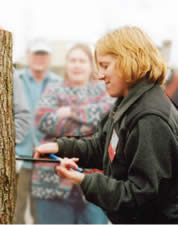In previous posts, we recommended that landowners get out into their woods to keep an eye on any changes that might be taking place, whether that be changes to the health of your trees or boundary problems. You can also keep track of physical changes to your trees by watching them grow and change over time. This month’s post will introduce ways you can assess your trees and woods. Future posts will delve deeper into these techniques with more specific details.
The best way to start tracking changes is to know which trees are present in your woods. The composition of our woods changes over time; the types of trees growing there is one way to measure this change. What trees are growing there now, and which trees will be growing there in 10-20 years when the big trees grow old and die? When you are out identifying your trees, make note of the types of trees that are above you, and the types of younger trees below you. The best tool to use for this is a tree identification key. Tree keys offer you choices, based on the characteristics of a given tree, to narrow down which tree you might be looking at. It will ask you about the shape of leaves, how a tree branches, what the bark looks like, and so on. Next month we will walk you through how to use a tree identification key and the associated terms.
You can also measure the changes in your woods over time by calculating growth, stocking, volume, and site index, to name a few. These measurements look at individual trees and the woods as a whole. In general, you are looking at how well are and could the trees be growing based on the resources (water, nutrients, sunlight) available. (For a refresher on this topic, check out the post How Do Trees and Forests Grow .) One basic measurement is the rings on an individual tree. A tool is available to take a very small core from a tree (this doesn’t injure the tree). The width between the individual rings can indicate how well a tree is growing. If the rings are close together, the tree doesn’t have enough resources available to put on much growth each year. In the tree ring photo, you can see the changes over time. The small rings starting in 1984 indicate when a disease started affecting the needles of this tree, which caused it to not be able to process sunlight and nutrients into growth.

Short of taking a core from each tree, we can measure the diameter of trees too, and over time get an idea of how the trees are growing. We can also measure how many trees are growing in a given area, and figure out whether that area can support the growth of that many trees. In other words, is there enough sunlight, water and nutrients to feed all those trees? Finally, we can evaluate the woods to determine whether the best trees are growing at that site. Each type of tree has preferences as to soil moisture, soil nutrients, and micro-climate. For example, in dry soils with poor nutrients in the northern and central parts of the state, jack pine can grow well. Foresters have specific tools and techniques to measure each of these variables, and in future posts, will delve deeper into a few of these that you can try in your woods.
Learning more about these tools and techniques will allow you to understand more about your woods than simply being a bunch of trees in your backyard. It will make your woods unique to you, and allow you to read the story your woods is writing.
